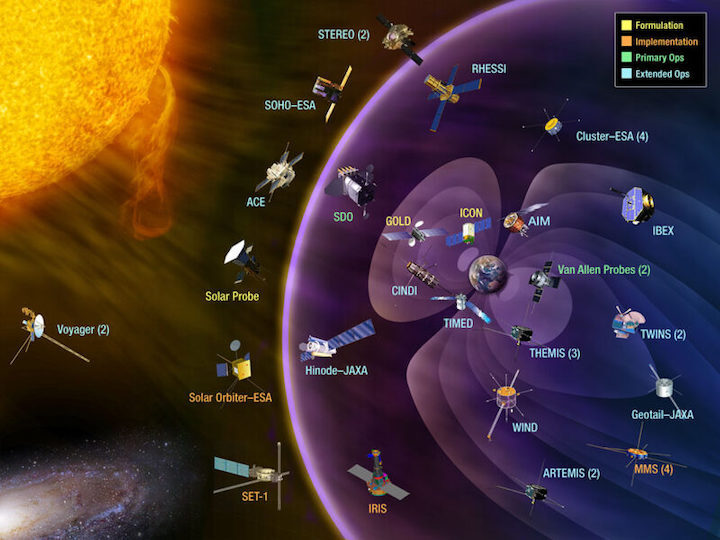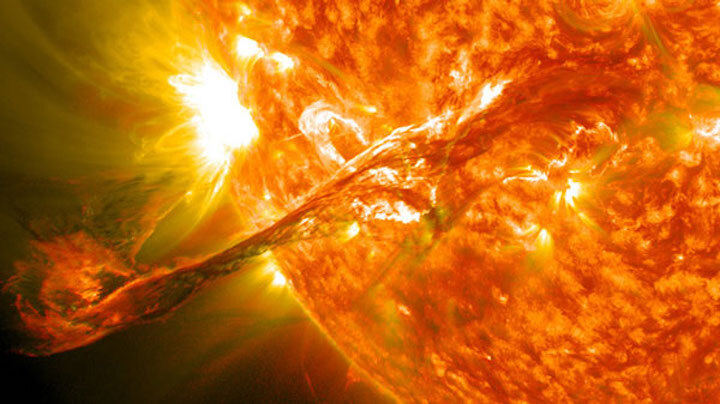13.02.2022
Scientists examining ancient ice cores have found radioactive evidence of an extreme solar storm that took place in 7,176 BCE.
An international team of researchers announced the discovery of fallout from an extreme solar storm entombed in ancient ice. The fact that the outburst occurred during a time when the Sun ought to have been quiet may be even more alarming than the storm’s magnitude.
Ice cores are long cylinders drilled from ice sheets and glaciers, frozen time capsules that allow scientists to reconstruct events in the distant past. The accumulating weight of each year’s snowfall compresses previous layers of snow, forming dense glacial ice that contains trapped gases, aerosols, and particles. The thick ice sheets in Antarctica and Greenland provide exceptionally well-preserved and detailed records of a variety of events that occurred up to 800,000 years ago — including variations in the level of solar activity.
When energetic charged particles strike atoms in the upper atmosphere, they produce three radioactive isotopes: carbon-14 (half-life 5,700 years), beryllium-10 (half-life 1.4 million years), and chlorine-36 (half-life 300,000 years). The production rate of these cosmogenic isotopesdepends on the intensity of cosmic radiation, though the strength of Earth’s magnetic field, which can deflect many charged particles, also plays a role.
Usually, most of the incoming charged particles are galactic cosmic rays, protons ejected by distant supernovas and the nuclei of active galaxies. Our planet is also buffeted by the solar wind, but this tenuous stream of particles actually shields us against more energetic radiation.
While the Sun is usually a well-behaved star, it does throw an occasional tantrum. When magnetic fields on the Sun twist and snap, explosive eruptions known as coronal mass ejections (CMEs) can eject a billion tons of charged particles into space and accelerate them to speeds of a million miles per hour. If Earth lies in the path of one of these magnetized bubbles of plasma, the resulting geomagnetic storm can wreak havoc on satellites, power grids, and wireless navigation and communication systems.
When Chiara Paleari (Lund University, Sweden) and colleagues analyzed concentrations of cosmogenic isotopes in ice cores from three sites in Greenland and one in Antarctica, they found a dramatic spike in cosmogenic isotopes around 9,198 years ago. Beryllium-10 suddenly increased by three to four times the background level, accompanied by a sixfold increase in chlorine-36. This may be the global fallout from the most intense solar storm in the last 10,000 years, they report in Nature Communications. By comparison, the fiercest geomagnetic storm ever observed directly, the Carrington Event of 1859, was at least 10 times less powerful.
Coronal mass ejections are 15 times more likely to occur near the maximum of the 11-year solar activity. Yet the solar tsunami 9,200 years ago, as well as a slightly less powerful one that occurred about 1,250 years ago, happened close to solar minimum. During the modern era, an intense solar storm in 1903 also occurred shortly after solar minimum, causing widespread disruption of telegraph and telephone networks and brilliant auroral displays that were visible at low latitudes in both the northern and southern hemispheres.
Is something vital lacking in our understanding of the Sun’s behavior? That isn’t just an academic question. If a similar superstorm happened today, it would deliver dangerous or even fatal doses of radiation to aviators and astronauts, fry the electronics of orbiting satellites, and cripple power grids.

This graphic shows the missions currently working as part of NASA's heliophysics fleet, helping scientists understand space weather and the Sun-Earth connection.
NASA
The Scientific Committee on Solar-Terrestrial Physics of the International Science Council is leading a concerted effort that seeks to understand the extreme range of activity that the Sun has displayed in the past and to predict what it may unleash in the future. NASA also just selected two science missions — the Multi-Slit Solar Explorer (MUSE) and HelioSwarm — to improve our understanding of the root causes of solar instability and the constantly changing space weather environment.
Quelle: Sky&Telescope

